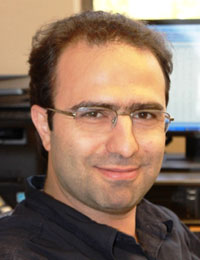Dr. Hamed Mohsenian-Rad receives a prestigious NSF CAREER Award for intelligent energy consumption scheduling agents
By Jeff Sammons

Dr. Hamed Mohsenian-Rad, an assistant professor of electrical and computer engineering at Texas Tech, has been selected to receive a $400,000 2012 NSF CAREER Award from the National Science Foundation. Mohsenian-Rad's award recognizes his career development plan entitled, "Self-Organizing Demand Side Management for Smart Grid: A Dynamic Game-Theoretic Framework." His research focuses on the application of dynamic game theory to demand-side power consumption management.
The electric power that we use each day is delivered to us through a sophisticated network of power plants, transmission systems, and distribution systems — the power grid. Unlike municipal water systems, extra power cannot be stored away in the grid until it is needed. Power companies must constantly monitor how much power is being used, predict how much power will be used throughout the day, and be ready to immediately scale up or scale down power generation to meet the demand of consumers. This variability often leads to instability in the grid, requiring power companies to act quickly to maintain consistency in the power that we receive.
As technological advances have increased, so has the demand load that consumers apply on the grid. Therefore, power companies are seeing higher and higher levels of consumer power consumption each year. Additionally, the peak usage load — or highest consumption level by consumers in a day — has been steadily increasing. The peak load can often be significantly greater than the average load of the rest of the day.
The cost of power generation at these peak times can be much higher, resulting in higher overall consumer energy pricing. Therefore, the Federal Energy Regulatory Commission has set a goal to shave peak usage loads by twenty percent.
At the same time, renewable energy options for power generation are representing a larger portion of total energy produced. The Department of Energy's vision for 2030 involves twenty percent of our electricity needs being met by wind power.
Unfortunately, wind power and other renewable energy sources are not as flexible and reliable as traditional fossil-fuel energy sources. Meeting consumer demand with renewable energy sources exclusively is virtually impossible with the variances that are present in today's daily power consumption profiles.

To address these two issues, power companies are seeking to shave peak loads and distribute power demand more evenly throughout the day. This balanced power generation profile will more closely match the capabilities of renewable energy sources, provide more stability in the grid, and allow for more efficient power generation. This profile shift, however, will not be possible without large-scale consumer participation.
This participation involves the changing of consumers' daily habits. Peak energy usage naturally occurs at times of convenience for consumers. In Texas, peak usage in August might occur in the late afternoon or early evening when consumers are home, running the air conditioner, cooking dinner in an electric oven, and with a variety of electronics operating. A consumer might also be charging their plug-in hybrid electric vehicle (PHEV) at this time.
To encourage changes in consumer behavior, some power companies are offering variable power rates for consumers. Each day, a cost schedule is developed that provides consumers with an hour-by-hour breakdown of power usage costs. Peak kilowatt-hour rates are significantly more expensive than low demand times. In this way, consumers are encouraged to change their behavior to reduce their energy costs. The variability of peak usage times, however, contributes to consumer confusion and inadvertent abandonment of the behavioral change.
A potential solution to the consumer behavioral change could be found in automated demand response systems or agents. These agents, built into or added onto consumer electronic appliances, devices and systems, monitor daily energy cost schedules and operate — on behalf of the consumer — to maximize cost savings through operation at non-peak times.
A consumer might have several of these agents or systems installed in their home. One system could be attached to the dishwasher. The consumer would instruct the agent to operate the dishwasher at the most efficient time in the next 12 hours. The agent would then review the power company's cost schedule and run the dishwasher at the time of the lowest cost per kilowatt-hour. Another system could be attached to a PHEV. Instead of charging the vehicle during a peak time, such as late afternoon in August, the agent would charge the vehicle in the middle of the night.

Mohsenian-Rad is taking these solutions several steps further to achieve large-scale integration of a unified intelligent energy consumption scheduling agent framework in several homes. He will also investigate interactions between these agents and with the utility companies in each neighborhood or region. Consumers set specific preferences for the agent, but the agent acts on the consumer's behalf throughout the day to schedule air conditioning, appliances, and other electronic devices to maximize individual consumer savings.
Additionally, Mohsenian-Rad is building tools to create agents that would work on behalf of larger areas, such as apartment complexes and industries. These systems — called decentralized self-organizing systems — make decisions based on the preferences of individual consumers first, but factor in the decisions of other consumers along with the stability of the larger power grid. These decentralized systems have the potential to help power companies meet their goals of load distribution throughout the day, while saving money for both consumers and power companies.
An inherent problem with large systems like this will be compromise. Not all consumers will be able to have all preferences met at all times. Mohsenian-Rad will use dynamic game theory to provide solutions that are in the best interest of all groups. Using the principles of this theory, he will be able to predict and respond to individual consumer preferences, both competitively and cooperatively. This will potentially allow for multiple consumers' energy consumption scheduling agents to coordinate their operations to obtain mutual benefits for participating consumers.
As a part of his research, he will develop a test network of household devices that will operate through his mathematical models and systems, to simulate both a centralized and a decentralized self-organizing demand response system.
Mohsenian-Rad joined the Department of Electrical and Computer Engineering in the Whitacre College of Engineering as an assistant professor in 2010. He received a Ph.D. in electrical and computer engineering from the University of British Columbia in 2008, a Master of Science in electrical engineering from Sharif University of Technology in 2004, and a Bachelor of Science in electrical engineering from Amir-Kabir University of Technology in 2002. He was a post-doctoral fellow at the University of Toronto in 2009 and 2010 before he joined Texas Tech University.
Edward E. Whitacre Jr. College of Engineering
-
Address
100 Engineering Center Box 43103 Lubbock, Texas 79409-3103 -
Phone
806.742.3451 -
Email
webmaster.coe@ttu.edu
